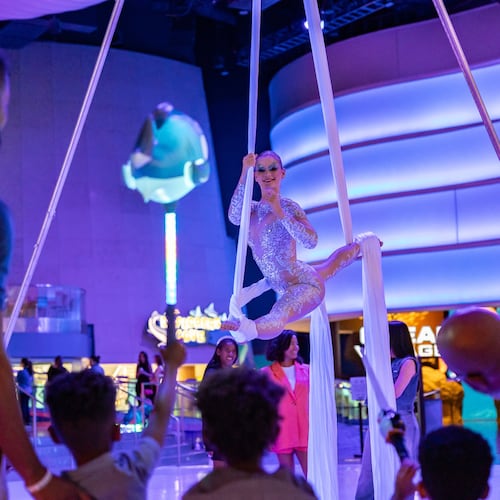Joe Overstreet had traveled a long road when he hit Manhattan in 1958 —- from tiny Conehatta, Miss., where he was born in 1933, through a series of moves that ultimately landed his family in California.
By the time he arrived in New York, the young painter was already accomplished, with several exhibitions to his credit in the San Francisco area. He quickly connected with a talented circle of painters; it was the heyday of abstract expressionism —- Hans Hoffman, Jackson Pollock, Willem de Kooning, all of whom influenced Overstreet's development.
By the late 1960s and '70s, Overstreet was well-established, independently and as part of a growing number of recognized black artists on the scene, among them Alvin Loving and Jack Whitten.
Throughout his five-decade career, Overstreet has shown an impressive range, from geometric abstraction to painted constructions and installation. But his passion for oils led him to a specific departure in the 1980s.
Inspired by tales of New Orleans he heard as a child, coupled with a passion for jazz, Overstreet created the "Storyville Series," 17 luminous, large-scale paintings focused on early 20th century New Orleans —- specifically, the notorious area known as Storyville, a district that openly embraced every conceivable vice, and an expressive new music called jazz.
On view at City Gallery East, the canvases in this series are irrepressibly beautiful —- languid, feverish, ambiguous —- they depict crowded clubs, gambling and prostitution, street scenes and music-making.
The artist's palette is powerful; it transforms otherwise gritty activities into celebrations of the unexpected or forbidden pleasures.
"Second Line II" is a vivid collision of geometric and figural forms mixing lavender, rose and inky tones —- unusual choices for a funeral procession. Pattern and color also predominate in "Leona Spinks" and "The Balcony," as sultry female contours take the spotlight.
"Garden Blues" is pure heat: It pulsates in a dense, vertical composition of horns and piano in fiery reds, blues and peach.
Timed to coincide with the Atlanta Jazz Festival, Overstreet's "Storyville Series" offers a delectable combination of hues and surfaces as vigorous brushwork and layering allow for fully exploiting oil as a medium: Surfaces build, shimmer and crumble —- the ideal metaphor for Storyville and its legacy, and as visually seductive as the music it honors.
REVIEW
"Storyville Series": Joe Overstreet
Through Aug. 1. 10 a.m.-5 p.m. Mondays-Saturdays. City Gallery East, 675 Ponce de Leon Ave., Atlanta. 404-817-6815.
Bottom line: A gorgeous, sultry series of abstract works by New York-based Overstreet celebrates the birth of jazz in early-20th- century New Orleans.
TWO ARTISTS SHOWCASED
Atlanta is fortunate to have ongoing solo exhibitions of two important American abstract artists who share Southern roots. Along with Joe Overstreet's "Storyville Series" at City Hall East, Jack Whitten's "Memorial Paintings" are on view at the Atlanta Contemporary Art Center.
Whitten's stunning mixed-media works are a striking personal tribute to key figures in the artist's life, and to the events of Sept. 11, 2001, in New York, which he witnessed. Whitten speaks Thursday at the High Museum.
Overstreet and Whitten are also both included in "Something to Look Forward To: Abstract Art by 22 Distinguished Americans of African Descent," a traveling exhibition on view at the Morris Museum of Art in Augusta, through May 25.
About the Author
Keep Reading
The Latest
Featured
